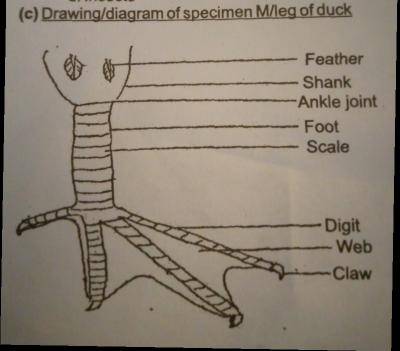Study specimens H,K,L,M and N and answer questions a to f
{a} state two observable structural differences between:
{i} specimens H and L
{ii} specimens K and M
{b}i state two ways each by which specimens H and M adapt the organisms to thier modes of life
H…………………………. M……………………………….
[ii] name two types of food that the organism that posseses specimen H feeds on
[c] make a drawing , 8cm to 10cm long of specimen k.
[d] name one habitat of the organism that posseses specimen k
[e] name one feeding habit of each of the organisms that posseses specimen H and L
H……………………………………….. M………………………………
[f] state two observable similarities between specimens:
i H and L
ii k and M
Explanation

[a] obseervable structural differences between
[i] specimens H and L
| H/head of domestic fowl | L/head of duck |
| presence of comb | comb absent |
| pointed/cylindrical/beak | flat/broad beak |
| short/stout beak | long beak |
| wattle present | wattle absent |
| beak not serrated | serrated beak |
[ii] specimens K and M
| K/Leg of domestic | M/Leg of duck |
| unwebbed toes | webbed toes/digits |
| curved/pointed claw | less curved/shorter/less pointed/curved claw |
| prominent backward digit | reduced backward digit |
| hind digit long | hind digit short |
[b][i] ways by which specimens H and M adapt the organisms to thier life
H
a.Eye at the side of head to focus on food on the ground / wide vision
b. short/stout beak; for picking grains/seeds from the soil/preening/courtship
M
a.webbed digits; for paddling / swimming
b. long digits; to balance while walking on land/muddy water to get food
c. claws; for defense/ scratching land to search for food
d. scales; to minimize dessication / protection
[ii] Type of food of the organism that possesses specimen H
a. grains/seeds
b. worms
c.vegetables
d. insects
[c] drawing of specimen M/leg of duck below;
[d] Habitat of the organism that posseses specimen K
Hencoop/terrestrial/land/on a tree/poultry/farmhomes/cage/farmyard
[e] feeding habit of specimens H and L
H: ominivore/ominivorous animal
L: filter feeding
[f] observable similarities between specimens
[i] H and L
Both have;
a. Beaks b.Ear opening c.Eyes
d. feathers e.Nostrils f.Neck
i K and M
both have
a. digits /four digits/three pointing foward and one point pointing backward
b. scales c.claws

